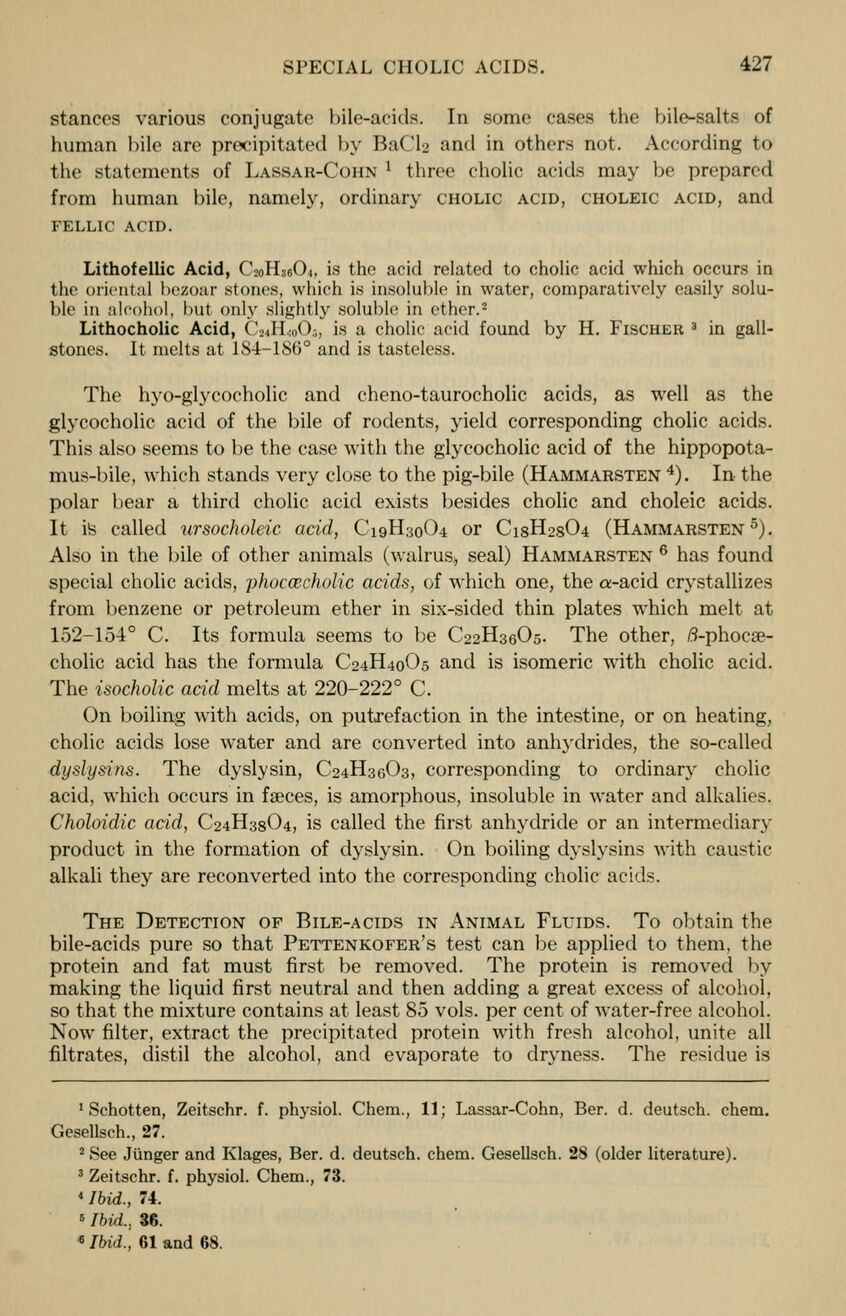
Full resolution (JPEG) - On this page / på denna sida - VII. The Liver - The Bile and its Formation

<< prev. page << föreg. sida << >> nästa sida >> next page >>
Below is the raw OCR text
from the above scanned image.
Do you see an error? Proofread the page now!
Här nedan syns maskintolkade texten från faksimilbilden ovan.
Ser du något fel? Korrekturläs sidan nu!
This page has never been proofread. / Denna sida har aldrig korrekturlästs.
SPECIAL CHOLIC ACIDS. 427
stances various conjugate1
bile-acids. In some cases the bile-Baits of
human bile arc precipitated by BaCta and in others not. According to
the statements of Lassar-Cohn l
three cholic acids may be prepared
from human bile, namely, ordinary cholic acid, choleic acid, and
fellic acid.
Lithofellic Acid, CsoHseCb, is the acid related to cholic acid which occurs in
the oriental bezoar stones, which is insoluble in water, comparatively easily solu-
ble in alcohol, but only slightly soluble in ether. 2
Lithocholic Acid, C^EUOs, is a cholic acid found by H. Fischer 3
in gall-
stones. It melts at 184-186° and is tasteless.
The hyo-glycocholic and cheno-taurocholic acids, as well as the
glycocholic acid of the bile of rodents, yield corresponding cholic acids.
This also seems to be the case with the glycocholic acid of the hippopota-
mus-bile, which stands very close to the pig-bile (Hammarsten 4
). In- the
polar bear a third cholic acid exists besides cholic and choleic acids.
It is called ursocholeic acid, C19H30O4 or C18H28O4 (Hammarsten 5
).
Also in the bile of other animals (walrus* seal) Hammarsten 6 has found
special cholic acids, phoccecholic acids, of which one, the cx-acid crystallizes
from benzene or petroleum ether in six-sided thin plates which melt at
152-154° C. Its formula seems to be C22H36O5. The other, tf-phocse-
cholic acid has the formula C24H40O5 and is isomeric wr
ith cholic acid.
The isocholic acid melts at 220-222° C.
On boiling with acids, on putrefaction in the intestine, or on heating,
cholic acids lose water and are converted into anhydrides, the so-called
dyslysins. The dyslysin, C24H36O3, corresponding to ordinary cholic
acid, which occurs in faeces, is amorphous, insoluble in water and alkalies.
Choloidic acid, C24H38O4, is called the first anhydride or an intermediary
product in the formation of dyslysin. On boiling dyslysins with caustic
alkali they are reconverted into the corresponding cholic acids.
The Detection of Bile-acids in Animal Fluids. To obtain the
bile-acids pure so that Pettenkofer’s test can be applied to them, the
protein and fat must first be removed. The protein is removed by
making the liquid first neutral and then adding a great excess of alcohol,
so that the mixture contains at least 85 vols, per cent of water-free alcohol.
Now filter, extract the precipitated protein with fresh alcohol, unite all
filtrates, distil the alcohol, and evaporate to dryness. The residue is
1
Schotten, Zeitschr. f. physiol. Chem., 11; Lassar-Cohn, Ber. d. deutsch. chem.
Gesellsch., 27.
2
See Junger and Klages, Ber. d. deutsch. chem. Gesellsch. 28 (older literature).
3
Zeitschr. f. physiol. Chem., 73.
4
Ibid., 74.
8
Ibid., 36.
6
Ibid., 61 and 68.
<< prev. page << föreg. sida << >> nästa sida >> next page >>